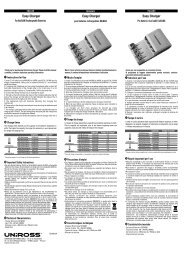UNIROSS Study on the Environmental Impact of ... - Battery Logic
UNIROSS Study on the Environmental Impact of ... - Battery Logic
UNIROSS Study on the Environmental Impact of ... - Battery Logic
You also want an ePaper? Increase the reach of your titles
YUMPU automatically turns print PDFs into web optimized ePapers that Google loves.
Printed <strong>on</strong> recycled paper<br />
Rechargeable batteries 8<br />
Rechargeable batteries,<br />
resp<strong>on</strong>sible c<strong>on</strong>sumpti<strong>on</strong><br />
Comp<strong>on</strong>ent<br />
sheets<br />
Electrolyte<br />
I<strong>on</strong>s<br />
Positive electrode<br />
The results <strong>of</strong> <strong>the</strong> <str<strong>on</strong>g>UNIROSS</str<strong>on</strong>g> study show <strong>the</strong> very clear envir<strong>on</strong>mental advantages <strong>of</strong><br />
rechargeable batteries compared with disposable batteries, for <strong>the</strong> same performance.<br />
How do rechargeable batteries work? How can <strong>the</strong>ir use be optimised and how can we<br />
reduce <strong>the</strong>ir impact <strong>on</strong> <strong>the</strong> envir<strong>on</strong>ment? <str<strong>on</strong>g>UNIROSS</str<strong>on</strong>g> proposes a quick user’s manual.<br />
I Disposable battery, rechargeable battery,<br />
what changes?<br />
There are two types <strong>of</strong> batteries:<br />
Single-use batteries, called disposable batteries, which c<strong>on</strong>tain a quantity <strong>of</strong> energy<br />
that is not renewable and which have a single life cycle, since <strong>the</strong>y are thrown away<br />
after each use.<br />
Rechargeable batteries can be recharged using a charger. They have a multiple life<br />
cycle and are recharged after each use.<br />
What happens inside a rechargeable battery?<br />
A rechargeable battery is made up <strong>of</strong> various sheets <strong>of</strong> comp<strong>on</strong>ents superposed and rolled<br />
up like <strong>the</strong> tobacco leaves in a cigar. At each extremity <strong>of</strong> <strong>the</strong> rechargeable battery, two<br />
electrodes are c<strong>on</strong>nected through an i<strong>on</strong>ically c<strong>on</strong>ductive soluti<strong>on</strong> called an electrolyte.<br />
From chemical energy to electric energy<br />
Each time it is recharged, a rechargeable battery transforms electric energy into<br />
chemical energy. When a device needs energy, <strong>the</strong> rechargeable battery c<strong>on</strong>verts<br />
<strong>the</strong> chemical energy back into electric energy.<br />
This is where <strong>the</strong>re is a radical difference between disposable batteries and<br />
rechargeable batteries: whereas <strong>the</strong> former finish <strong>the</strong>ir life cycle and are thrown<br />
F<br />
away or head for recycling, <strong>the</strong> latter can be recharged hundreds <strong>of</strong> times with<br />
chargers.<br />
What is <strong>the</strong> capacity <strong>of</strong> a rechargeable battery?<br />
The capacity <strong>of</strong> a rechargeable battery is <strong>the</strong> quantity <strong>of</strong> energy that it<br />
can store, and release to power a device. It is expressed in mAh<br />
(milliampere-hour).<br />
The greater <strong>the</strong> capacity (mAh), <strong>the</strong> l<strong>on</strong>ger <strong>the</strong> battery will last before<br />
needing to be recharged.<br />
Today, research has made it possible to develop rechargeable batteries<br />
with a capacity <strong>of</strong> 800mAh up to 2700mAh for an R6 format.<br />
Negative electrode



